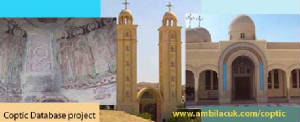|

|
| Click on above image to access the project leaflet |
Premise
To develop a fully multi-media database of the Coptic
monasteries of Egypt, producing a fully searchable and interactive catalogue of the monastic sites.
By developing such a database, which will include
full text descriptions, photographs and video, the end result would be an ideal and important tool for retrieval of archaeological
records and for Coptic research in general.
New: Satellite images and photographs of the Coptic monastic sites in Egypt in conjunction with the Coptic database
Update - Power Point Presentation as shown at the 2007 Current Research in Egypt conference - Swansea University- Introduction
to the Coptic Database - Click mouse to advance each slide
Link here for the related Power Point Presentation notes
Introduction:
While in recent years Coptic studies
witnessed a remarkable progress especially in monastic art, actual monastic site documentation appears to have been sadly
lacking. It is with this consideration in mind the idea of the design and development of the Coptic Multi-Media Database
was born.
There
are a considerable number of Coptic monasteries distributed throughout mainly desert areas in Egypt, some in ruinous condition,
and indeed a large number possibly never documented at all. However, many of these monasteries contain extremely rare and
important architectural and archaeological elements, such as ancient wall paintings, icons and unique carvings.
It
is extremely important that these sites be systematically documented and recorded, and while a few have been excavated over
the years, a system whereby the resulting pooled information may be accessed alongside interactive visual multi media documentation,
has, until now, not been available.
To this end, it was proposed in 2007 to instigate the design and development of such a database, which was based
on the design of the Akhmim project (1997)
By
developing such a database, which includes; full text descriptions, photographs and video, satellite imagery, exact GPS coordinates,
bibliographies and complete descriptions of the art and architectural elements, the end result would be a unique and important
tool for the retrieval (and reconstruction) of archaeological records of Monastic sites.
With
the cooperation of Coptic researchers and associated organisations, the end result would not only greatly improve and enhance
our understanding of the Coptic heritage, but also provide vital and essential data towards the preservation and restoration
of important Monastic sites, thus maintaining a credible resource for the continuation of Coptic culture.
Howard
Middleton-Jones
Our 2005
trip already has provided much visual documentation, such as high quality filming of a number of monasteries and the rare
wall paintings of St Gabriel in the Fayoum area.
Advantages of the
Coptic Database Project
- To pool resources and data into one major location
- To enable rapid search and find to generate reports
- To enable map generation and overlays of Monastic site distribution
- To provide accurate geographical locations of sites
- As a major source of references and bibliographies
- To access multi-media film, photographs and satellite imaging
- To provide vital data and information from excavation reports
- As a tool for the retrieval of reports to aid preservation and conservation
- To enhance our understanding of the Coptic culture and promote the Coptic heritage
The project is already underway and regular progress bulletins will be posted - if
anyone wishes to contribute to the database in anyway, and possesses material for inclusion, please contact me
|

